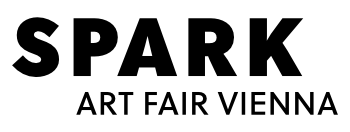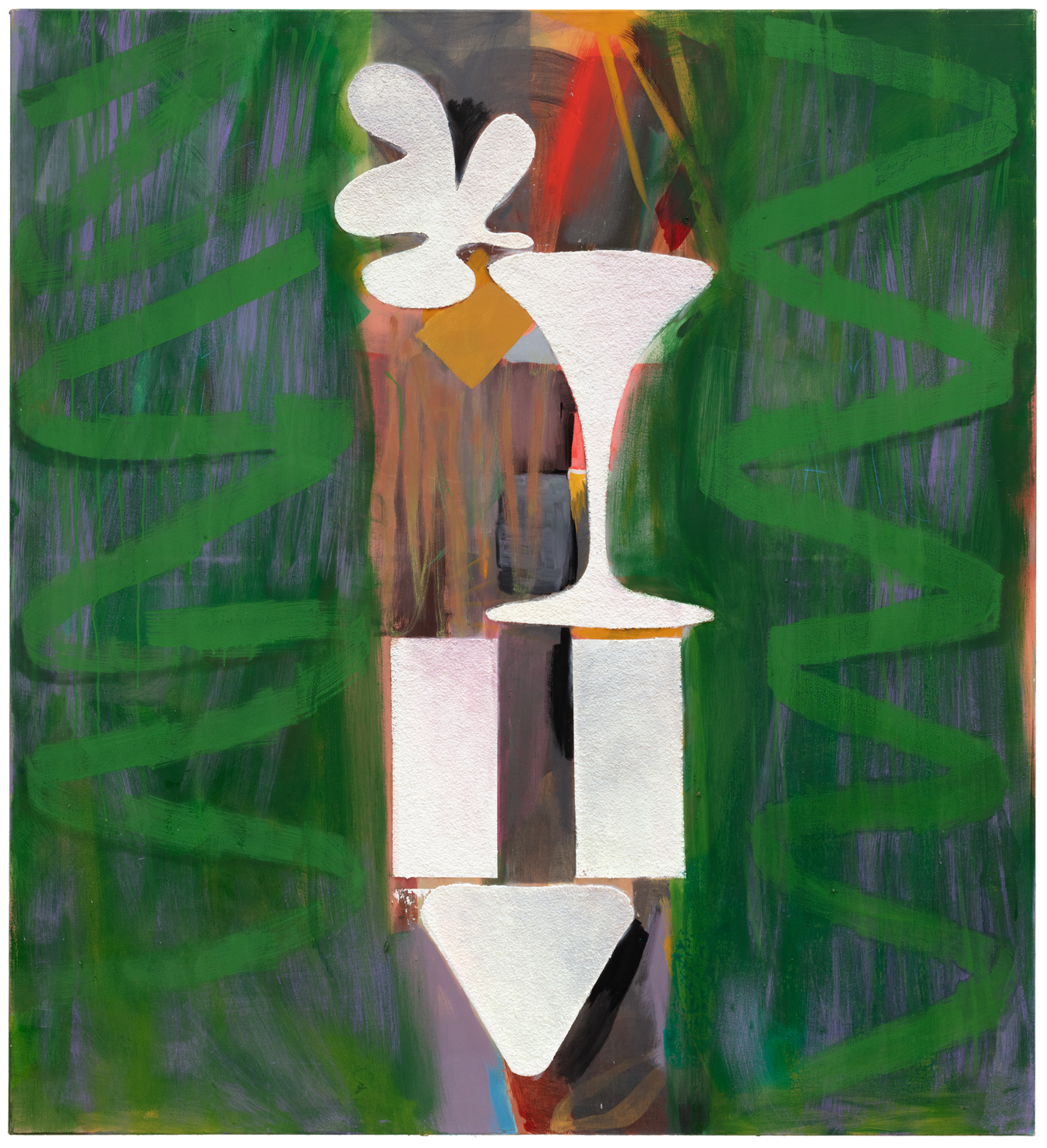Galerie nächst St. Stephan Rosemarie Schwarzwälder
Luisa Kasalicky
Luisa Kasalicky creates works that are located at the intersection of installation, painting, and sculpture and combine constructivist stylistic elements with baroque fixtures. Her narrative arrangements of simple forms are reminiscent of theater stage sets and can be understood as reactions to the media homogenization of visual image production in photography and film today.
Kasalicky strives to do justice to the everyday raw materials and building stuffs – like plastic foam, bitumen panels, wood, tiles, and synthetic carpets – that she uses. On the one hand, these materials relate to her childhood and are cultural and anthropological relics from the 1970s and ’80s. On the other hand, they stress tactile qualities and possess a painterly value based on their particular color, texture, and materiality. Her motifs, some of which are expansive, express a strong desire for a clear language of form that upholds a baroque tendency toward the sublime, despite the heaviness of the materials used. Kasalicky also integrates the creative potential and artisanal value of ornaments into her working world.
Kasalicky’s installations playfully indulge in narration, staging painting as baroque theatrical backdrops and reflecting on the sensual immediacy of conscious perception. Like her installation pieces, her traditional tempera panel paintings created in her studio also narratively weave together the individual motifs in the pictorial space. (Anja Werkl)
Biography
Born 1974 in Prague, Czech Republic, lives and works in Vienna, Austria
Kasalicky studied at the Glasfachschule (Glass Art Academy) Kramsach, Tyrol, Austria, from 1996 to 1998 and painting at the Akademie der bildenden Künste (Academy of Fine Arts) Vienna with Gunter Damisch 1998–2004.
Luisa Kasalicky has had solo exhibitions at venues such as the Lentos Museum, Linz, Austria; Kunstraum Burgkapelle -Museum Moderner Kunst Kärnten, Klagenfurt, Austria; House of Arts – Galerie G99, Brno, Czech Republic; and BAWAG Contemporary, Vienna, Austria. She was awarded the Otto Mauer Prize in 2013.
Galerie nächst St. Stephan Rosemarie Schwarzwälder
The Galerie nächst St. Stephan represents a living tradition of exploring the art of the modern era. It has been located since the 1920’s in the same place in the center of Vienna at Grünangergasse.
With the exhibition: Zeichen, Fluten, Signale – neukonstruktiv und parallel („Signs, Waves, Signals – Reconstructive and Parallel“) Rosemarie Schwarzwälder presented a program in 1984, which featured basic elements that have proven relevant in numerous solo and group exhibitions up to the present. International positions of abstraction and concept-based art in the areas of painting, sculpture, installations, photography and video have maintained a continuous presence in the program of the gallery.
„It became taken for granted that nothing relating to art could be taken for granted any longer.“ (T.W. Adorno)
Modern or contemporary art today needs discourse. Organizing symposia and independent publications is part of the gallery’s self-image.
Issues of the development of art, international cultural comparisons and the validity of aesthetic criteria have been addressed in publications.
– Abstrakte Malerei aus Amerika und Europa / Abstract Painting of America and Europe, Brice Marden, Gerhard Richter, Helmut Federle, Robert Mangold, Robert Ryman, Galerie nächst St. Stephan Rosemarie Schwarzwälder, Wien/Klagenfurt 1988
– Kulturen — Verwandschaften in Geist und Form, Galerie nächst St. Stephan Rosemarie Schwarzwälder, Wien 1991
– Abstrakte Malerei zwischen Analyse und Synthese / Abstract Painting Between Analysis and Synthesis, Galerie nächst St. Stephan Rosemarie Schwarzwälder, Wien/Klagenfurt 1992
– numerous artist catalogues

+4315121266
Melanie Harl
+4315121266-16
Luisa Kasalicky
Luisa Kasalicky creates works that are located at the intersection of installation, painting, and sculpture and combine constructivist stylistic elements with baroque fixtures. Her narrative arrangements of simple forms are reminiscent of theater stage sets and can be understood as reactions to the media homogenization of visual image production in photography and film today.
Kasalicky strives to do justice to the everyday raw materials and building stuffs – like plastic foam, bitumen panels, wood, tiles, and synthetic carpets – that she uses. On the one hand, these materials relate to her childhood and are cultural and anthropological relics from the 1970s and ’80s. On the other hand, they stress tactile qualities and possess a painterly value based on their particular color, texture, and materiality. Her motifs, some of which are expansive, express a strong desire for a clear language of form that upholds a baroque tendency toward the sublime, despite the heaviness of the materials used. Kasalicky also integrates the creative potential and artisanal value of ornaments into her working world.
Kasalicky’s installations playfully indulge in narration, staging painting as baroque theatrical backdrops and reflecting on the sensual immediacy of conscious perception. Like her installation pieces, her traditional tempera panel paintings created in her studio also narratively weave together the individual motifs in the pictorial space. (Anja Werkl)
Biography
Born 1974 in Prague, Czech Republic, lives and works in Vienna, Austria
Kasalicky studied at the Glasfachschule (Glass Art Academy) Kramsach, Tyrol, Austria, from 1996 to 1998 and painting at the Akademie der bildenden Künste (Academy of Fine Arts) Vienna with Gunter Damisch 1998–2004.
Luisa Kasalicky has had solo exhibitions at venues such as the Lentos Museum, Linz, Austria; Kunstraum Burgkapelle -Museum Moderner Kunst Kärnten, Klagenfurt, Austria; House of Arts – Galerie G99, Brno, Czech Republic; and BAWAG Contemporary, Vienna, Austria. She was awarded the Otto Mauer Prize in 2013.
Galerie nächst St. Stephan Rosemarie Schwarzwälder
The Galerie nächst St. Stephan represents a living tradition of exploring the art of the modern era. It has been located since the 1920’s in the same place in the center of Vienna at Grünangergasse.
With the exhibition: Zeichen, Fluten, Signale – neukonstruktiv und parallel („Signs, Waves, Signals – Reconstructive and Parallel“) Rosemarie Schwarzwälder presented a program in 1984, which featured basic elements that have proven relevant in numerous solo and group exhibitions up to the present. International positions of abstraction and concept-based art in the areas of painting, sculpture, installations, photography and video have maintained a continuous presence in the program of the gallery.
„It became taken for granted that nothing relating to art could be taken for granted any longer.“ (T.W. Adorno)
Modern or contemporary art today needs discourse. Organizing symposia and independent publications is part of the gallery’s self-image.
Issues of the development of art, international cultural comparisons and the validity of aesthetic criteria have been addressed in publications.
– Abstrakte Malerei aus Amerika und Europa / Abstract Painting of America and Europe, Brice Marden, Gerhard Richter, Helmut Federle, Robert Mangold, Robert Ryman, Galerie nächst St. Stephan Rosemarie Schwarzwälder, Wien/Klagenfurt 1988
– Kulturen — Verwandschaften in Geist und Form, Galerie nächst St. Stephan Rosemarie Schwarzwälder, Wien 1991
– Abstrakte Malerei zwischen Analyse und Synthese / Abstract Painting Between Analysis and Synthesis, Galerie nächst St. Stephan Rosemarie Schwarzwälder, Wien/Klagenfurt 1992
– numerous artist catalogues

